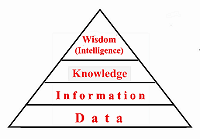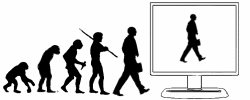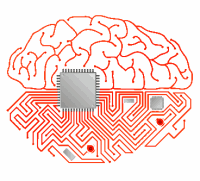 The first working brain simulation? Spaun (Semantic Pointer Architecture Unified Network) has attracted a good deal of interested coverage.
The first working brain simulation? Spaun (Semantic Pointer Architecture Unified Network) has attracted a good deal of interested coverage.
Spaun is based on the nengo neural simulator: it basically consists of an eye and a hand: the eye is presented with a series of pixelated images of numbers (on a 28 x 28 grid) and the hand provides output by actually drawing its responses. With this simple set up Spaun is able to perform eight different tasks ranging from copying the digit displayed to providing the correct continuation of a number sequence in the manner of certain IQ tests. Its performance within this limited repertoire is quite impressive and the fact that it fails in a few cases actually makes it resemble a human brain even more closely. It cannot learn new tasks on its own, but it can switch between the eight at any time without impairing its performance.
Spaun seems to me an odd mixture of approaches; in some respects it is a biologically realistic simulation, in others its structure has just been designed to work. It runs on 2.5 million simulated neurons, far fewer than those used by purer simulations like Blue Brain; the neurons are essentially designed to work in a realistic way, although they are relatively standardised and stereotyped compared to their real biological counterparts. Rather than being a simple mass of neurons or a copy of actual brain structures they are organised into an architecture of modules set up to perform discrete tasks and supply working memory, etc. If you wanted to be critical you could say that this mixing of simulation and design makes the thing a bit kludgeish, but commentators have generally (and rightly, I think) not worried about that too much. It does seem plausible that Spaun is both sufficiently realistic and sufficiently effective for us to conclude it is really demonstrating in practice the principles of how neural tissue supports cognition – even if a few of the details are not quite right.
Interesting in this respect is the use of semantic pointers. Apparently these are compressions of multidimensional vectors expressed by spiking neurons; it looks as though they may provide a crucial bridge between the neuronal and the usefully functional, and they are the subject of a forthcoming book, which should be interesting.
What’s the significance of Spaun for consciousness? Well, for one thing it makes a significant contribution to the perennial debate on whether or not the brain is computational. There is a range of possible answers which go something like the following.
- Yes, absolutely. The physical differences between a brain and a PC are not ultimately important; when we have identified the right approach we’ll be able to see that the basic activity of the brain is absolutely standard Turing-style computations.
- Yes, sort of. The brain isn’t doing computation in quite the way silicon chips do it, but the functions are basically the same, just as a plane doesn’t have flapping feathery wings but is still doing the same thing – flying – as a bird.
- No, but. What the brain does is something distinctively different from computation, but it can be simulated or underpinned by computational systems in a way that will work fine.
- No, the brain isn’t doing computations and what it is doing crucially requires some kind of hardware which isn’t a computer at all, whether it’s some quantum gizmo or something with some other as yet unidentified property which biological neurons have.
The success of Spaun seems to me to lend a lot of new support to position 3: to produce the kind of cognitive activity which gives rise to consciousness you have to reproduce the distinctive activity of neurons – but if you simulate that well enough by computational means, there’s no reason why a sufficiently powerful computer couldn’t support consciousness.



 So IBM is at it again: first chess, now
So IBM is at it again: first chess, now  The latest issue of the JCS features David Chalmers’
The latest issue of the JCS features David Chalmers’  Paul Almond’s Attempt to Generalize AI has reached Part 8:
Paul Almond’s Attempt to Generalize AI has reached Part 8: 
 Where has AI (or perhaps we should talk about
Where has AI (or perhaps we should talk about  Kenneth Rogoff is
Kenneth Rogoff is  I see via MLU that Robert Sloan at the University of Illinois at Chicago has been given half a million dollars for a
I see via MLU that Robert Sloan at the University of Illinois at Chicago has been given half a million dollars for a